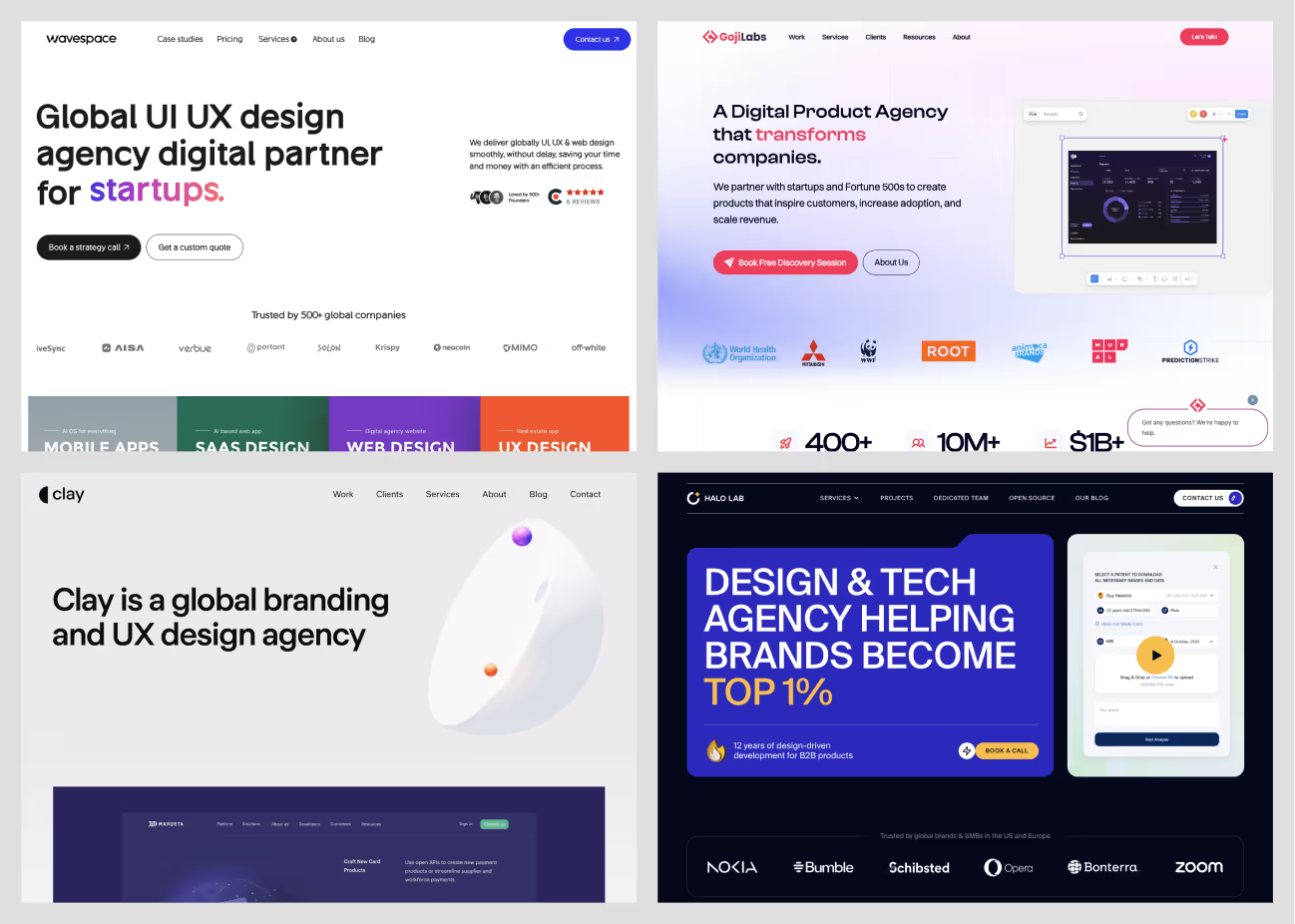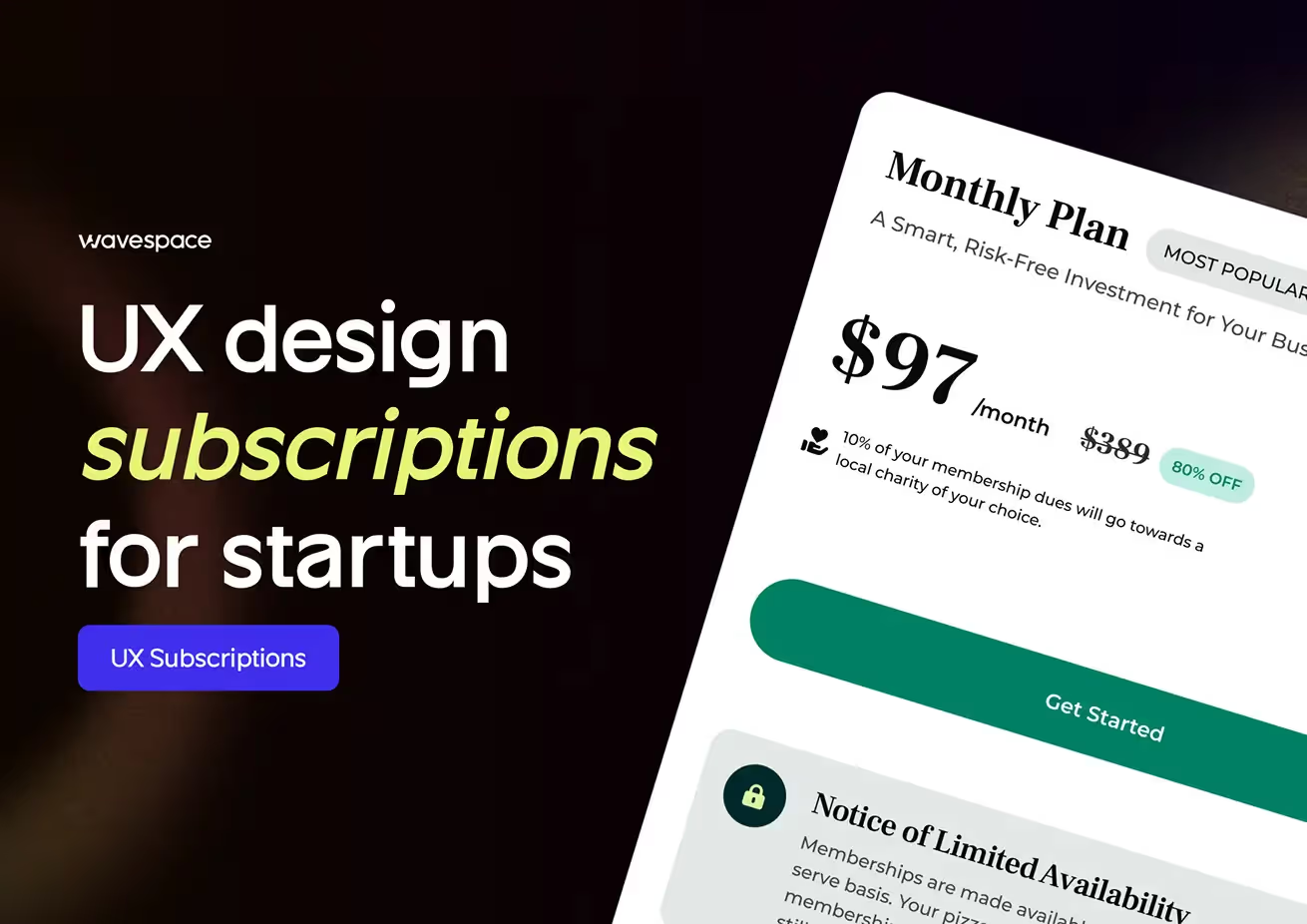How UI/UX Design Agencies Help Startups Launch 3X Faster


This guide explains how UI/UX design agencies help startups validate ideas faster, reduce redesign costs, and attract early users, supported by real SaaS and fintech case studies.
Why Do Most Startups Struggle to Launch Fast?
Most startups slow down because they jump from idea to code without validating design assumptions.
Founders usually focus on funding and features, not user clarity. According to CB Insights’ Startup Failure Post-Mortem, 42 percent of failed startups cite “no market need” as the main reason, a UX validation problem. In the absence of initial research and prototypes, teams will spend months on a feature that no one desires.
Design Thinking and early Lean UX discovery are techniques used by a good UI/UX agency to discover needs before development. Structured sprinting narrows the vision, user goals, and brand narrative. According to the Business Value of Design report by McKinsey, companies that are design-mature are already 32% ahead of others in terms of revenue growth. Clear design has a rapidity of each subsequent step, including stakeholder buy-in to engineering velocity.
Launch speed starts with validated insight, not bigger budgets.
Why Does Design Speed Determine Startup Survival?
Design speed defines survival because faster iteration equals faster learning.
Startups operate on limited runways, often 12–18 months. Every delay reduces the market window and investor patience. Harvard Business Review’s analysis, The New Rules of Digital Speed, notes that companies moving from concept to market 50 percent faster grow revenue 2× more than competitors. Agile design methods create that tempo.
Ideation, prototyping, and testing Frameworks like the Google Ventures Design Sprint boil assumptions to evidence and get through ideation, prototyping, and testing in five days. An agency of UI/UX takes care of these loops by applying the principles of Lean UX: hypothesize, prototype, measure, iterate. The result is measurable speed without chaos: decisions made on feedback, not opinion.
Each validated sprint buys extra months of survival.
What Does a UI/UX Design Agency Actually Do for Startups?

A UI/UX design agency can bring vague ideas to reality in the form of investor-ready digital experiences.
The process typically comprises user research, information architecture, wireframing and prototyping, user interface design systems, and handoff to the developer.. Every step shortens later revisions. In the study of ROI of UX conducted by Nielsen Norman Group, 1$ spent on UX generates 100$ in value by minimizing errors and speeding up. Agencies bring multidisciplinary alignment, strategists, UX researchers, UI artists, and front-end specialists working in synchronized sprints.
In contrast to freelancers or small in-house departments, agencies use replicable systems, which transform research into production-ready interfaces—the outcome: faster time-to-market, cleaner code integration, and measurable user impact.
An experienced MVP design agency combines research, UX strategy, and systemized design to help startups move from idea to validation quickly.
A great interface isn’t art; it’s an acceleration tool.

How Does a UI/UX Design Agency Accelerate Launch?
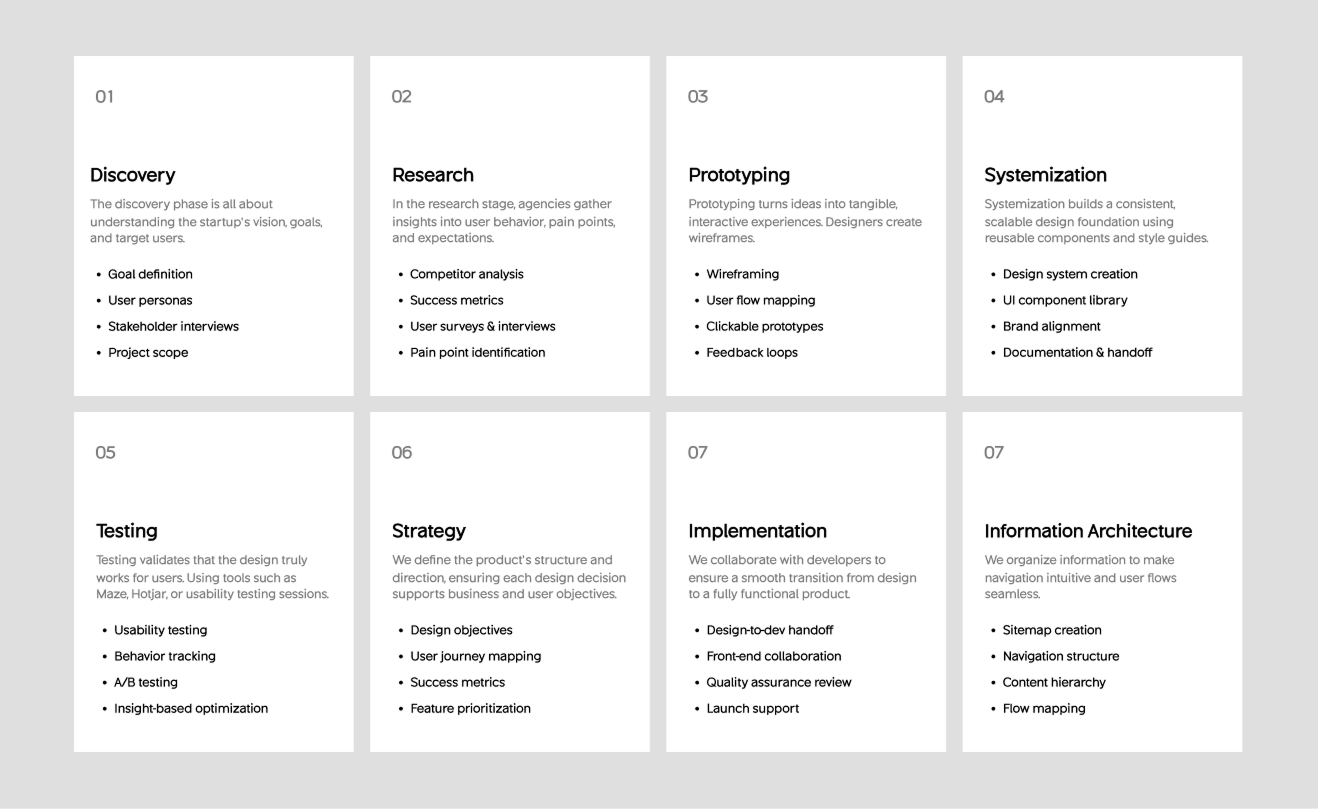
An agency also speeds up the start by substituting the linear hand-offs with the parallel, data-driven processes.
A common process has five stages: Discovery, Research, Prototyping, Systemization, Testing. Discovery workshops make business goals and personas clear. Research quantifies pain points. Prototyping creates clickable flows for real feedback. Systemization builds reusable UI libraries in Figma or React. Testing tools such as Maze and Hotjar validate usability before development.
According to the Sprint Playbook by Google Design, a 50% reduction in the decision-making process with rapid prototyping can be achieved. Rather than six-month roadways, agencies end up with six-week deliverables running these loops every week without quality or innovation tradeoffs.
Hustle does not bring about sustainable speed, but process discipline does.
How Do Agencies Turn Research into Actionable Design?
Agencies can turn research to design decisions by relating data to quantifiable outcomes.
They start with user interviews, analytics, and competitor benchmarks, merging qualitative “why” with quantitative “how often.” The output of findings is personas and journey maps that are prioritized with Lean UX hypothesis statements. Every cycle will be testing one assumption, such as, does this onboarding flow decrease drop-off by 15 percent?
According to Nielsen Norman Group, it is better to connect each UX decision with a business metric. Good agencies put these KPIs right into design dashboards so that task success, retention, or NPS can be seen by the founders and investors.
Forrester’s CX Index shows that each 1-point gain in experience quality can add millions in annual revenue. When research informs action, design becomes a growth lever rather than a cost line. Data without application is insight wasted; agencies turn it into momentum.
What Real Results Show How UX Agencies Accelerate Launches?
Across industries, from SaaS accounting to AI development and fintech, UX-led redesigns show how structured design turns functionality into momentum. Each project below demonstrates how clarity, usability, and brand trust directly impact adoption and growth.
These projects showcase how a SaaS design agency and fintech UX design experts accelerate launches across industries.
Case Study 1 — Spacebook
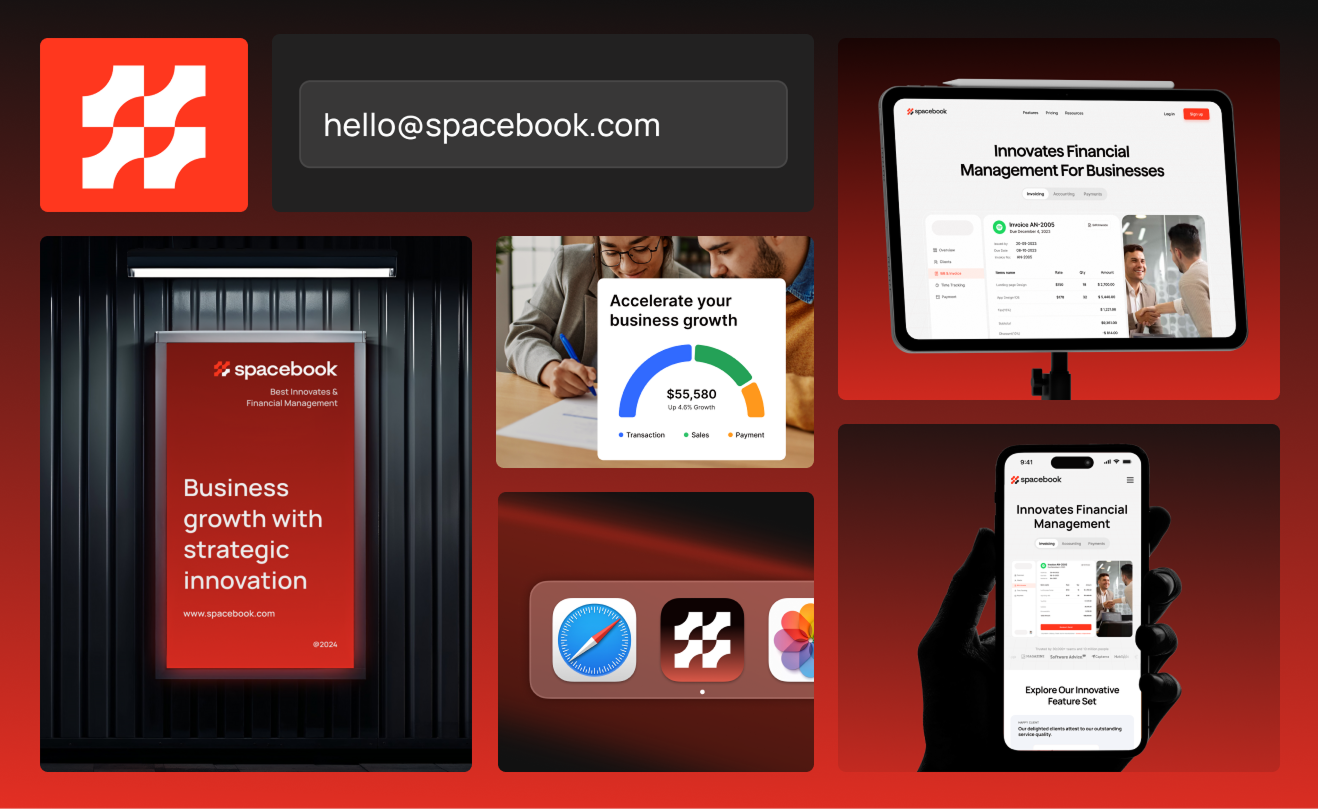
Spacebook is a SaaS firm based in San Francisco that offers accounting services to small and medium-sized enterprises. Their backend was quite strong, but users tended to drop off after one initial session. We redesigned the dashboard to focus on clarity, visual hierarchy, and faster access to key actions like invoicing and tax summaries.
We also used Design Thinking workshops and user journey mapping to find out where the drop-off points were most, which were the onboarding and invoice track processes. The redesign included a guided onboarding process, card layouts that could be broken down into modules, and cleaner navigation that was based on a scale design system.
Since the launch, Spacebook has achieved an increase in satisfaction of its users by 25 percent, new user growth by 40 percent, returning users by 35 percent, and investment growth by 4.6 percent monthly. Low friction and trust enhanced the usability of Spacebook as its competitive advantage.
The lesson: even powerful products fail if design doesn’t communicate their value quickly.
Case Study 2 — Kodezi

Kodezi is a coding assistant, the Grammarly of programmers, an AI-based program. People did not know how or why technology was important, even though it was a strong one. To close that communication gap, we redesigned the whole experience of Kodezi, their product design, brand system, and their website.
We developed a developer-friendly interface of bold design, a clear onboarding flow, through the Lean UX methodology, user testing, and brand identity design. All features, such as autofix, documentation, and analysis, became visible in a single consistent system. The redesign brought together their CLI, web, and mobile platforms, making them more usable and aesthetically aligned.
The post-launch data revealed that 92 percent of users went through onboarding without any aids, 70 percent found the essential features sooner, and 85 percent liked the new interface.
Clarity and narrative consistency can turn complex AI into accessible software that sells itself.
Case Study 3 — Quicky
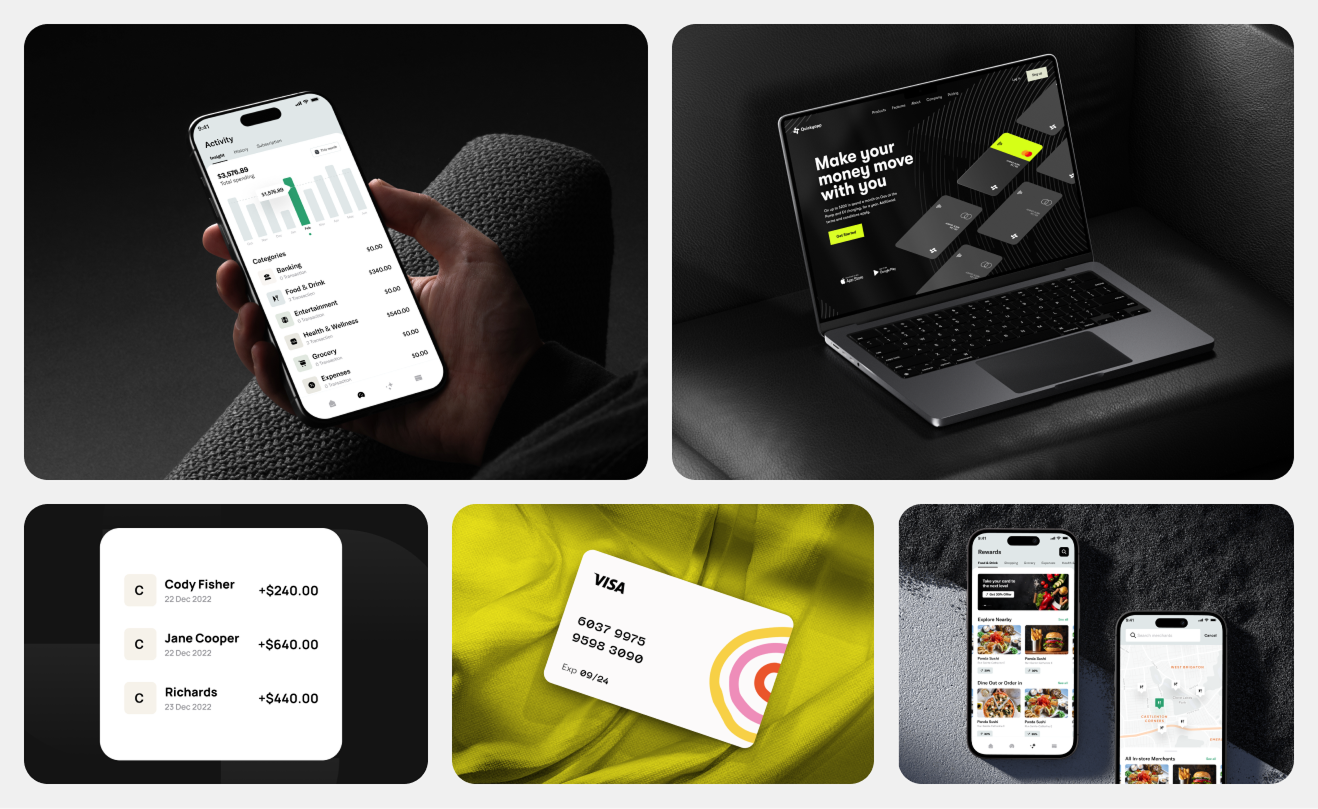
Quicky went out to make personal finance easy to use by ordinary people, when it comes to sending money, bill sharing, and expense tracking. The idea was good, but it was not well represented in the initial design, which lacked consistency, clarity, and user confidence. We created a secure and friendly visual identity and simplified all major flows.
Our UX research revealed major drop-offs during transactions and onboarding. Using insights from usability tests, we implemented real-time feedback, visual hierarchy, and accessible navigation patterns. The new interface was in a simple black and white foundation with colorful accents to generate energy and readability.
Following the redesign, 82% of users said that they felt more confident, 68% of users felt that transactions were easier, and 91% thought the interfaces were more modern and trustworthy. The rate of adoption of the app increased when Quicky was no longer a working finance tool but an empowering digital companion.
In fintech, user trust is designed to build currency, clarity, and feedback.

What Tools and Frameworks Do UI/UX Agencies Use to Work Faster?
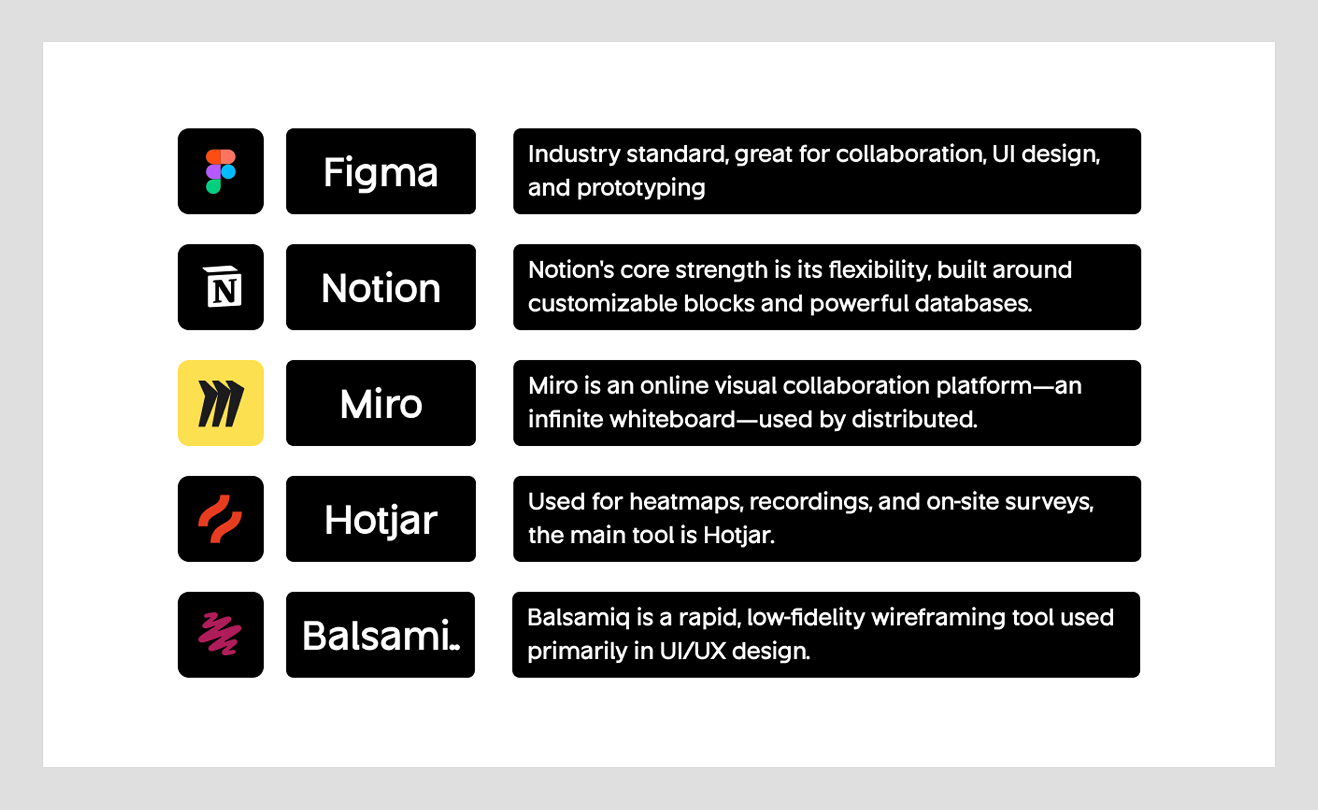
The State of Creativity report by Adobe states that cross-functional teams that utilize cloud-based design tools are 47 percent more productive. The shared repositories and standardized processes allow ensuring speed and consistency improvement rather than rework creation in each iteration.
The right tools turn creativity into measurable velocity.

How Does Great UX Design Influence Funding and Investor Confidence?
Good UX design is an indicator of maturity, making it seem less risky to investors.
The early-stage investors seek execution discipline more than market potential. A polished prototype with validated flows demonstrates that founders understand their users and metrics. In McKinsey’s study on design-led growth, firms that integrate UX into strategy see 56 percent higher shareholder returns. For venture capital, that translates to faster scaling and lower burn per milestone.
Agencies help startups in developing that investor story by creating high-fidelity prototypes and quantifiable feedback from the users. Once a demo boasts of retention rates or drop-off decreases supported by analytics providers like Mixpanel or Amplitude, investors consider the product a de-risked product. UX, therefore, becomes a proof of competence, not decoration.
Clear design clarity builds investor trust long before revenue does.

How Do Agencies Build MVPs That Attract Early Users?

The early users of agencies are attracted by simplicity, emotion, and usability being mixed into the MVP design.
The MVP goal is validation, not perfection. Agencies use Design Thinking to find one problem with high impact and resolve it beautifully. They prototype key journeys, integrate friction-free onboarding, and design feedback loops that encourage engagement. The Nielsen Norman Group claims that up to 80 percent of the continued adoption relies on first-time UX.
Empathy is followed by early adoption: build what the user feels and not what you think.

Why Do Founders Prefer Agencies Over Building In-House Teams?
The founders like agencies since they can access multidisciplinary expertise immediately without the expense and time wastage of employment. An agency gathers UX strategists, researchers, designers, and developers who are already integrated in a single workflow.
Building that in-house often takes 3–6 months and raises payroll by 40–60 percent, based on Glassdoor salary research. Agencies bring cross-industry experience: based on projects in fintech, AI, and healthtech, agencies make more informed decisions about new startups.
Beyond speed, agencies carry repeatable playbooks, design systems, usability frameworks, and QA pipelines that guarantee predictable outcomes. This level of maturity minimizes founders' control, which enables leadership to pay attention to product-market fitting and funding.
Once you hire an agency in UI/UX, you have an immediate, full multidisciplinary team without recruitment delays.
What Are the Biggest Myths About Fast Design?
A number of myths warp the perception of design speed by founders.
Myth 1: “Fast means sloppy.”
→ Reality: Agile UX improves precision through continuous testing. The issues are revealed in each sprint to avoid costly redesigns in future.
Myth 2: “Skipping research saves time.”
→ Reality: It is five times more expensive to correct UX issues once the website has been launched, Nielsen Norman Group states.
Myth 3: “Design systems kill creativity.”
→ Reality: Systems remove repetition so designers can focus on innovation.
Myth 4: “Speed kills quality.”
→ Reality: Lean UX ensures that every iteration adds evidence, not guesswork. Regular velocity decreases chaos instead of developing it.
True agility balances exploration with discipline, never confusion.
What Common Startup Design Mistakes Should Be Avoided?
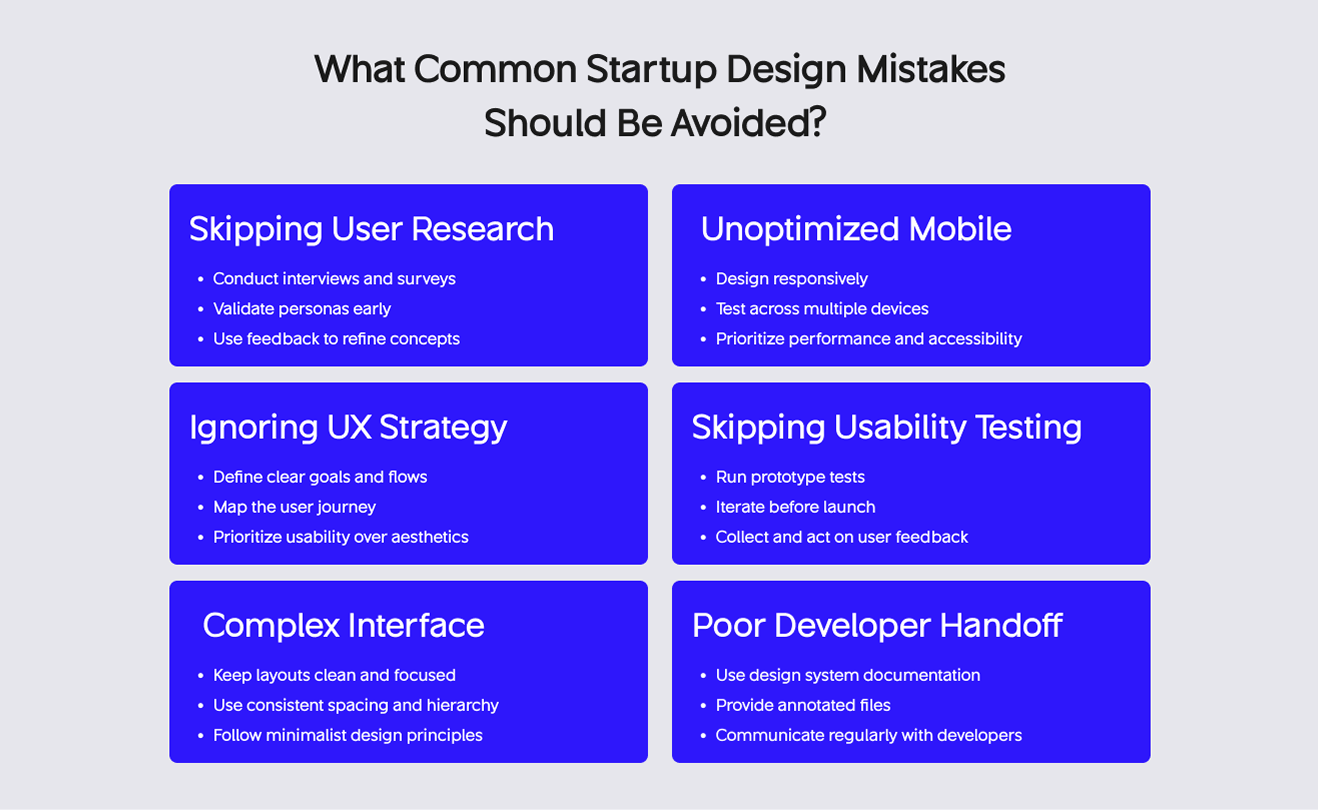
Common mistakes include skipping validation, overloading features, and ignoring accessibility.
How Can Startups Design Faster Without Losing Quality?
Startups are designed more quickly without compromising the quality through process standardization and prioritizing evidence over opinion.
They start with Design Thinking to empathize and identify the pain points of users, and then embrace the Lean UX cycles to be hypothesis-driven. Scaling visuals can be done instantly with design systems, tokenized color, spacing, and rules of typography. Such usability platforms as Useberry or Lookback can deliver feedback in a few hours, allowing for making design changes the same day.
Speed and quality are not opposites; they’re products of disciplined iteration.
How Design Turns Ideas into Launches That Last
Design transforms ideas into momentum when speed and insight move together. Launching fast is not just about shipping early in the current market, but it is also about learning early. When user experience is integrated into the DNA of the startup, it adapts quickly, consumes less capital, and gives greater trust to the investor. An effective UI/UX design agency will join discovery, research, prototyping, and systemization into a single continuous cycle of validation.
When founders treat design as infrastructure rather than aesthetics, every decision compounds: usability drives retention, clarity drives funding, and consistency drives trust. According to McKinsey, design-mature firms beat their competitor by double-digit growth in both revenue and overall returns. It is a very simple formula: clarity x consistency x speed = longevity.
When collaborating with the appropriate UI/UX design agency, one is likely to turn good ideas into fast, fundable products.
FAQ about How a UI/UX Design Agency Helps Startups
How long does it take a UI/UX agency to design an MVP?
Most agencies deliver a validated MVP in 6 – 10 weeks, depending on complexity. In frameworks such as the Google Ventures Design Sprint, discovery, prototyping, and testing are performed in parallel rather than sequential order, which eliminates friction in the timeline.
Does faster design compromise quality?
No. Lean UX and Agile UX workflows rely on continuous validation. Each iteration collects measurable feedback, improving precision rather than rushing output. According to Nielsen Norman Group, iterative testing can reduce rework costs by 80 percent.
How does great UX help secure funding?
Investors associate strong UX with execution discipline. Data from McKinsey’s Business Value of Design report shows that design-led firms achieve 56 percent higher shareholder returns, proving that clarity and user evidence de-risk investment decisions.
What metrics prove good UX performance?
The important indicators are task-completion rate, retention, NPS, LCP, and INP. These KPIs are built directly into dashboards by agencies using tools such as Hotjar and Mixpanel to enable founders to connect design enhancement with actual ROI.
When should a startup hire a UI/UX agency?
Ideally, there is are concept and a target audience before development. Early design saves 40-60 percent of engineering expenses in the future, and the MVP that satisfies real-world requirements as opposed to assumptions.
How UI/UX Design Agencies Help Startups Launch 3X Faster

This guide explains how UI/UX design agencies help startups validate ideas faster, reduce redesign costs, and attract early users, supported by real SaaS and fintech case studies.
Why Do Most Startups Struggle to Launch Fast?
Most startups slow down because they jump from idea to code without validating design assumptions.
Founders usually focus on funding and features, not user clarity. According to CB Insights’ Startup Failure Post-Mortem, 42 percent of failed startups cite “no market need” as the main reason, a UX validation problem. In the absence of initial research and prototypes, teams will spend months on a feature that no one desires.
Design Thinking and early Lean UX discovery are techniques used by a good UI/UX agency to discover needs before development. Structured sprinting narrows the vision, user goals, and brand narrative. According to the Business Value of Design report by McKinsey, companies that are design-mature are already 32% ahead of others in terms of revenue growth. Clear design has a rapidity of each subsequent step, including stakeholder buy-in to engineering velocity.
Launch speed starts with validated insight, not bigger budgets.
Why Does Design Speed Determine Startup Survival?
Design speed defines survival because faster iteration equals faster learning.
Startups operate on limited runways, often 12–18 months. Every delay reduces the market window and investor patience. Harvard Business Review’s analysis, The New Rules of Digital Speed, notes that companies moving from concept to market 50 percent faster grow revenue 2× more than competitors. Agile design methods create that tempo.
Ideation, prototyping, and testing Frameworks like the Google Ventures Design Sprint boil assumptions to evidence and get through ideation, prototyping, and testing in five days. An agency of UI/UX takes care of these loops by applying the principles of Lean UX: hypothesize, prototype, measure, iterate. The result is measurable speed without chaos: decisions made on feedback, not opinion.
Each validated sprint buys extra months of survival.
What Does a UI/UX Design Agency Actually Do for Startups?

A UI/UX design agency can bring vague ideas to reality in the form of investor-ready digital experiences.
The process typically comprises user research, information architecture, wireframing and prototyping, user interface design systems, and handoff to the developer.. Every step shortens later revisions. In the study of ROI of UX conducted by Nielsen Norman Group, 1$ spent on UX generates 100$ in value by minimizing errors and speeding up. Agencies bring multidisciplinary alignment, strategists, UX researchers, UI artists, and front-end specialists working in synchronized sprints.
In contrast to freelancers or small in-house departments, agencies use replicable systems, which transform research into production-ready interfaces—the outcome: faster time-to-market, cleaner code integration, and measurable user impact.
An experienced MVP design agency combines research, UX strategy, and systemized design to help startups move from idea to validation quickly.
A great interface isn’t art; it’s an acceleration tool.

How Does a UI/UX Design Agency Accelerate Launch?

An agency also speeds up the start by substituting the linear hand-offs with the parallel, data-driven processes.
A common process has five stages: Discovery, Research, Prototyping, Systemization, Testing. Discovery workshops make business goals and personas clear. Research quantifies pain points. Prototyping creates clickable flows for real feedback. Systemization builds reusable UI libraries in Figma or React. Testing tools such as Maze and Hotjar validate usability before development.
According to the Sprint Playbook by Google Design, a 50% reduction in the decision-making process with rapid prototyping can be achieved. Rather than six-month roadways, agencies end up with six-week deliverables running these loops every week without quality or innovation tradeoffs.
Hustle does not bring about sustainable speed, but process discipline does.
How Do Agencies Turn Research into Actionable Design?
Agencies can turn research to design decisions by relating data to quantifiable outcomes.
They start with user interviews, analytics, and competitor benchmarks, merging qualitative “why” with quantitative “how often.” The output of findings is personas and journey maps that are prioritized with Lean UX hypothesis statements. Every cycle will be testing one assumption, such as, does this onboarding flow decrease drop-off by 15 percent?
According to Nielsen Norman Group, it is better to connect each UX decision with a business metric. Good agencies put these KPIs right into design dashboards so that task success, retention, or NPS can be seen by the founders and investors.
Forrester’s CX Index shows that each 1-point gain in experience quality can add millions in annual revenue. When research informs action, design becomes a growth lever rather than a cost line. Data without application is insight wasted; agencies turn it into momentum.
What Real Results Show How UX Agencies Accelerate Launches?
Across industries, from SaaS accounting to AI development and fintech, UX-led redesigns show how structured design turns functionality into momentum. Each project below demonstrates how clarity, usability, and brand trust directly impact adoption and growth.
These projects showcase how a SaaS design agency and fintech UX design experts accelerate launches across industries.
Case Study 1 — Spacebook

Spacebook is a SaaS firm based in San Francisco that offers accounting services to small and medium-sized enterprises. Their backend was quite strong, but users tended to drop off after one initial session. We redesigned the dashboard to focus on clarity, visual hierarchy, and faster access to key actions like invoicing and tax summaries.
We also used Design Thinking workshops and user journey mapping to find out where the drop-off points were most, which were the onboarding and invoice track processes. The redesign included a guided onboarding process, card layouts that could be broken down into modules, and cleaner navigation that was based on a scale design system.
Since the launch, Spacebook has achieved an increase in satisfaction of its users by 25 percent, new user growth by 40 percent, returning users by 35 percent, and investment growth by 4.6 percent monthly. Low friction and trust enhanced the usability of Spacebook as its competitive advantage.
The lesson: even powerful products fail if design doesn’t communicate their value quickly.
Case Study 2 — Kodezi

Kodezi is a coding assistant, the Grammarly of programmers, an AI-based program. People did not know how or why technology was important, even though it was a strong one. To close that communication gap, we redesigned the whole experience of Kodezi, their product design, brand system, and their website.
We developed a developer-friendly interface of bold design, a clear onboarding flow, through the Lean UX methodology, user testing, and brand identity design. All features, such as autofix, documentation, and analysis, became visible in a single consistent system. The redesign brought together their CLI, web, and mobile platforms, making them more usable and aesthetically aligned.
The post-launch data revealed that 92 percent of users went through onboarding without any aids, 70 percent found the essential features sooner, and 85 percent liked the new interface.
Clarity and narrative consistency can turn complex AI into accessible software that sells itself.
Case Study 3 — Quicky

Quicky went out to make personal finance easy to use by ordinary people, when it comes to sending money, bill sharing, and expense tracking. The idea was good, but it was not well represented in the initial design, which lacked consistency, clarity, and user confidence. We created a secure and friendly visual identity and simplified all major flows.
Our UX research revealed major drop-offs during transactions and onboarding. Using insights from usability tests, we implemented real-time feedback, visual hierarchy, and accessible navigation patterns. The new interface was in a simple black and white foundation with colorful accents to generate energy and readability.
Following the redesign, 82% of users said that they felt more confident, 68% of users felt that transactions were easier, and 91% thought the interfaces were more modern and trustworthy. The rate of adoption of the app increased when Quicky was no longer a working finance tool but an empowering digital companion.
In fintech, user trust is designed to build currency, clarity, and feedback.

What Tools and Frameworks Do UI/UX Agencies Use to Work Faster?

The State of Creativity report by Adobe states that cross-functional teams that utilize cloud-based design tools are 47 percent more productive. The shared repositories and standardized processes allow ensuring speed and consistency improvement rather than rework creation in each iteration.
The right tools turn creativity into measurable velocity.

How Does Great UX Design Influence Funding and Investor Confidence?
Good UX design is an indicator of maturity, making it seem less risky to investors.
The early-stage investors seek execution discipline more than market potential. A polished prototype with validated flows demonstrates that founders understand their users and metrics. In McKinsey’s study on design-led growth, firms that integrate UX into strategy see 56 percent higher shareholder returns. For venture capital, that translates to faster scaling and lower burn per milestone.
Agencies help startups in developing that investor story by creating high-fidelity prototypes and quantifiable feedback from the users. Once a demo boasts of retention rates or drop-off decreases supported by analytics providers like Mixpanel or Amplitude, investors consider the product a de-risked product. UX, therefore, becomes a proof of competence, not decoration.
Clear design clarity builds investor trust long before revenue does.

How Do Agencies Build MVPs That Attract Early Users?

The early users of agencies are attracted by simplicity, emotion, and usability being mixed into the MVP design.
The MVP goal is validation, not perfection. Agencies use Design Thinking to find one problem with high impact and resolve it beautifully. They prototype key journeys, integrate friction-free onboarding, and design feedback loops that encourage engagement. The Nielsen Norman Group claims that up to 80 percent of the continued adoption relies on first-time UX.
Empathy is followed by early adoption: build what the user feels and not what you think.

Why Do Founders Prefer Agencies Over Building In-House Teams?
The founders like agencies since they can access multidisciplinary expertise immediately without the expense and time wastage of employment. An agency gathers UX strategists, researchers, designers, and developers who are already integrated in a single workflow.
Building that in-house often takes 3–6 months and raises payroll by 40–60 percent, based on Glassdoor salary research. Agencies bring cross-industry experience: based on projects in fintech, AI, and healthtech, agencies make more informed decisions about new startups.
Beyond speed, agencies carry repeatable playbooks, design systems, usability frameworks, and QA pipelines that guarantee predictable outcomes. This level of maturity minimizes founders' control, which enables leadership to pay attention to product-market fitting and funding.
Once you hire an agency in UI/UX, you have an immediate, full multidisciplinary team without recruitment delays.
What Are the Biggest Myths About Fast Design?
A number of myths warp the perception of design speed by founders.
Myth 1: “Fast means sloppy.”
→ Reality: Agile UX improves precision through continuous testing. The issues are revealed in each sprint to avoid costly redesigns in future.
Myth 2: “Skipping research saves time.”
→ Reality: It is five times more expensive to correct UX issues once the website has been launched, Nielsen Norman Group states.
Myth 3: “Design systems kill creativity.”
→ Reality: Systems remove repetition so designers can focus on innovation.
Myth 4: “Speed kills quality.”
→ Reality: Lean UX ensures that every iteration adds evidence, not guesswork. Regular velocity decreases chaos instead of developing it.
True agility balances exploration with discipline, never confusion.
What Common Startup Design Mistakes Should Be Avoided?

Common mistakes include skipping validation, overloading features, and ignoring accessibility.
How Can Startups Design Faster Without Losing Quality?
Startups are designed more quickly without compromising the quality through process standardization and prioritizing evidence over opinion.
They start with Design Thinking to empathize and identify the pain points of users, and then embrace the Lean UX cycles to be hypothesis-driven. Scaling visuals can be done instantly with design systems, tokenized color, spacing, and rules of typography. Such usability platforms as Useberry or Lookback can deliver feedback in a few hours, allowing for making design changes the same day.
Speed and quality are not opposites; they’re products of disciplined iteration.
How Design Turns Ideas into Launches That Last
Design transforms ideas into momentum when speed and insight move together. Launching fast is not just about shipping early in the current market, but it is also about learning early. When user experience is integrated into the DNA of the startup, it adapts quickly, consumes less capital, and gives greater trust to the investor. An effective UI/UX design agency will join discovery, research, prototyping, and systemization into a single continuous cycle of validation.
When founders treat design as infrastructure rather than aesthetics, every decision compounds: usability drives retention, clarity drives funding, and consistency drives trust. According to McKinsey, design-mature firms beat their competitor by double-digit growth in both revenue and overall returns. It is a very simple formula: clarity x consistency x speed = longevity.
When collaborating with the appropriate UI/UX design agency, one is likely to turn good ideas into fast, fundable products.
FAQ about How a UI/UX Design Agency Helps Startups
How long does it take a UI/UX agency to design an MVP?
Most agencies deliver a validated MVP in 6 – 10 weeks, depending on complexity. In frameworks such as the Google Ventures Design Sprint, discovery, prototyping, and testing are performed in parallel rather than sequential order, which eliminates friction in the timeline.
Does faster design compromise quality?
No. Lean UX and Agile UX workflows rely on continuous validation. Each iteration collects measurable feedback, improving precision rather than rushing output. According to Nielsen Norman Group, iterative testing can reduce rework costs by 80 percent.
How does great UX help secure funding?
Investors associate strong UX with execution discipline. Data from McKinsey’s Business Value of Design report shows that design-led firms achieve 56 percent higher shareholder returns, proving that clarity and user evidence de-risk investment decisions.
What metrics prove good UX performance?
The important indicators are task-completion rate, retention, NPS, LCP, and INP. These KPIs are built directly into dashboards by agencies using tools such as Hotjar and Mixpanel to enable founders to connect design enhancement with actual ROI.
When should a startup hire a UI/UX agency?
Ideally, there is are concept and a target audience before development. Early design saves 40-60 percent of engineering expenses in the future, and the MVP that satisfies real-world requirements as opposed to assumptions.
Get a team of skilled professionals and get the benefits of a global UI/UX design agency.
Have a Project? Let’s talk!













